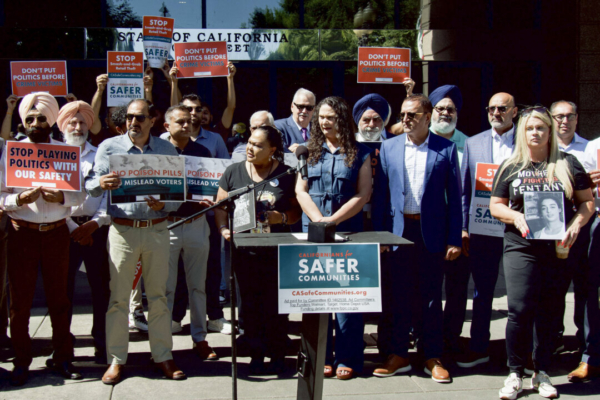According to the latest survey released by the Public Policy Institute of California (PPIC) on September 19, approximately 71% of potential voters in California support Proposition 36, which aims to repeal Proposition 47 passed by voters ten years ago.
Proposition 36, also known as the “Reducing Homelessness, Addiction, and Theft Act”, seeks to increase penalties for certain drug and theft offenses.
“Everyone seems to be in support,” said Deja Thomas, an analyst at PPIC, in response to questions from the media during the release of the survey results.
The report shows that a majority of respondents identifying as Democrats, Republicans, and Independents expressed support for Proposition 36, with approval rates of 63%, 85%, and 73% respectively.
Grouped by different ideologies, or categories such as residential area, gender, race, age, presence of children in the household, education level, household income, birthplace, and homeownership status, various segments demonstrated broad support for Proposition 36.
Men showed an 8 percentage point higher support than women, at 75% and 67% respectively, while Latino respondents had the highest support among all racial groups, with 75% in favor.
Individuals who completed high school but did not pursue higher education showed the highest level of support for Proposition 36, with 81% in favor; among respondents with some college education and college graduates, 67% and 70% respectively indicated they would vote in support.
The group with the lowest household income displayed the lowest support for Proposition 36 at 65%; in contrast, 76% of those with an annual income between $40,000 and $80,000 indicated approval, while 72% of households with an income over $80,000 expressed support.
Age had the most significant impact on support, with 61% of potential voters aged 18-44 in favor of the proposition, compared to 77% of respondents aged 45 and above who expressed support.
Respondents also noted that Proposition 36 was deemed the most important among the 10 ballot measures in the November election. PPIC’s statewide survey director Mark Baldassare stated in a press release, “Among the 10 statewide ballot measures, Proposition 36 leads in terms of support, attention, and importance.”
The number of people considering Proposition 36 a priority is twice that of Proposition 4, the “Safe Drinking Water Bond Act,” and Proposition 33, “Expand Government Authority to Implement Rent Control.”
Conducted online from August 29 to September 9, the survey involved 1,605 Californians, including 1,071 potential voters. The researchers calculated a margin of error of 3.1% for all respondents and approximately 3.7% for likely voters.
Supporters of Proposition 36 argue that the measure is necessary to address the impact of Proposition 47. According to the campaign website “Support Proposition 36,” the ballot measure has garnered support from hundreds of local businesses, hundreds of local governments and officials, over a hundred business organizations, over a hundred law enforcement officials, and dozens of community groups.
Opponents, however, argue that Proposition 36 could lead to high costs and negatively impact the state by shifting funds from community programs to prisons.
Governor Gavin Newsom has expressed concern that the proposition would increase prison populations and leans towards moderate reforms to Proposition 47, such as the recent California legislation he signed.
Newsom also stated that Proposition 36 calls for a restoration of 1980s drug policies.
In debates within the legislature and statewide, experts on both sides have presented various viewpoints.
A study released by PPIC on September 17 found that the criminal justice reforms in Proposition 47 led to a decrease in prison populations but also resulted in an increase in certain criminal activities. By reclassifying some serious offenses as misdemeanors, California saw a reduction of approximately 13,000 inmates in prison, saving around $800 million in state funds.
However, the study concluded that the legal changes from Proposition 47 likely contributed to a “statistically significant” increase in crime, including a 2.1% rise in property crimes and a significant 3.9% spike in vehicle thefts.
The lower clearance rates (percentage of crimes resolved through arrest and prosecution) might be related to Proposition 47, as the likelihood of a suspect in property crimes being arrested is only half of what it was in 2014.
The researchers noted in their report: “The reclassification of certain property/drug felonies as misdemeanors may affect the arrest strategies and discretion of law enforcement. Voters sent a signal to law enforcement-related criminal justice officials: that reclassified drug/property offenses should be viewed as less serious and require responses other than incarceration.”
The study also concluded that one-third of car theft cases could be attributed to Proposition 47; arrests for related crimes decreased by about 10% within two years of the proposition’s passage, leading to a corresponding decrease in the number of cases resolved.
The researchers highlighted two impacts: when policies reduce sentences and give offenders more opportunities to commit crimes, and when the likelihood of being caught decreases and offenders no longer fear consequences, it likely contributed to an increase in criminal activity over the past decade.
The researchers also stated that increased probability of arrest is more effective in deterring crime compared to longer sentences. In other words, the ease of getting caught is more of a deterrent than severe punishment.
Supporters of Proposition 36 believe that the ballot measure will address some of the issues stemming from Proposition 47.
Greg Totten, the Chief Executive Officer of the California District Attorneys Association, conveyed on a recent episode of EpochTV’s “California Insider”: “Many serious offenders (realize) there are no consequences, and they commit more crimes, causing harm to small businesses and large retailers. Those who repeatedly plunder retailers will face felony charges.”

